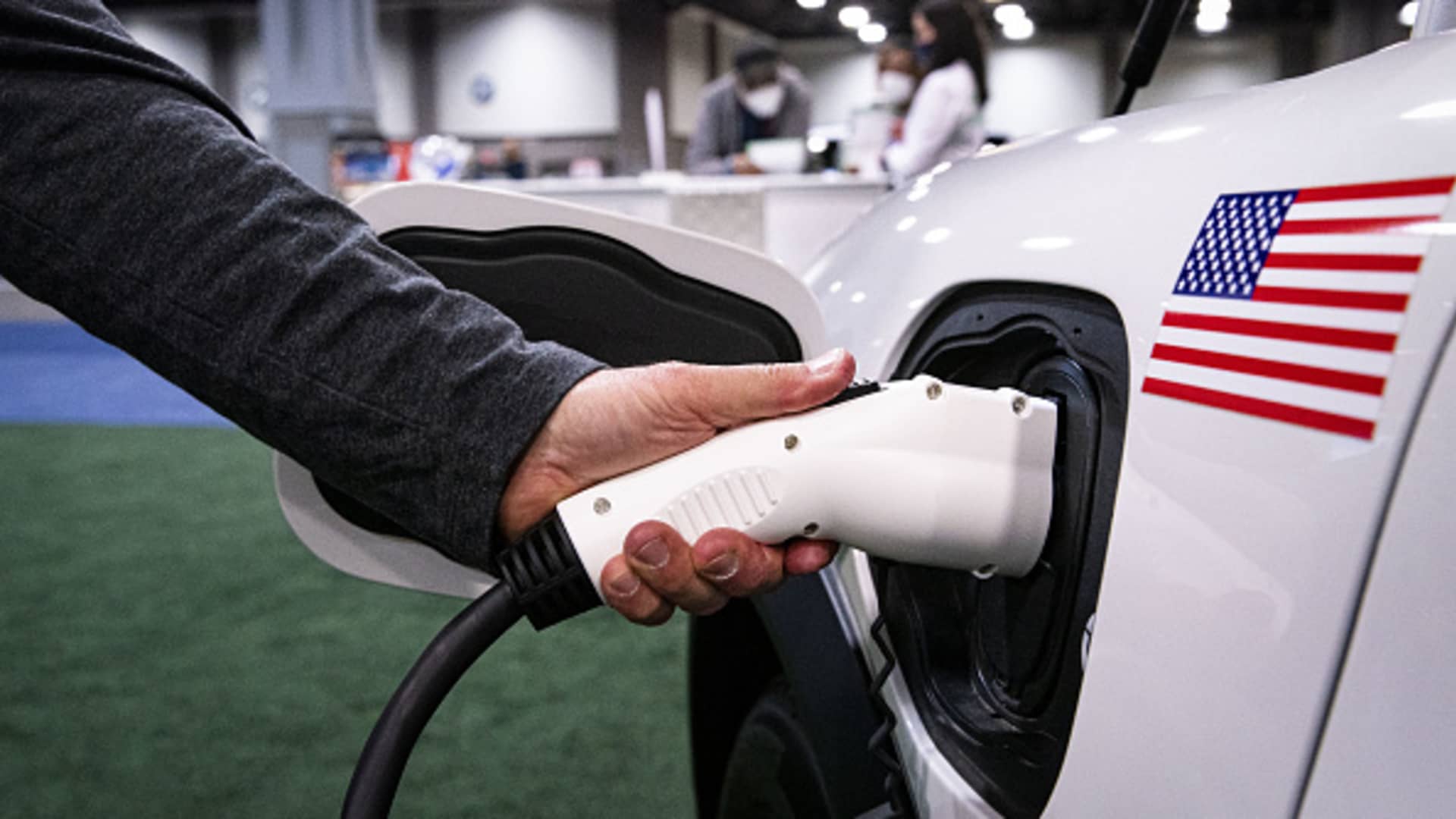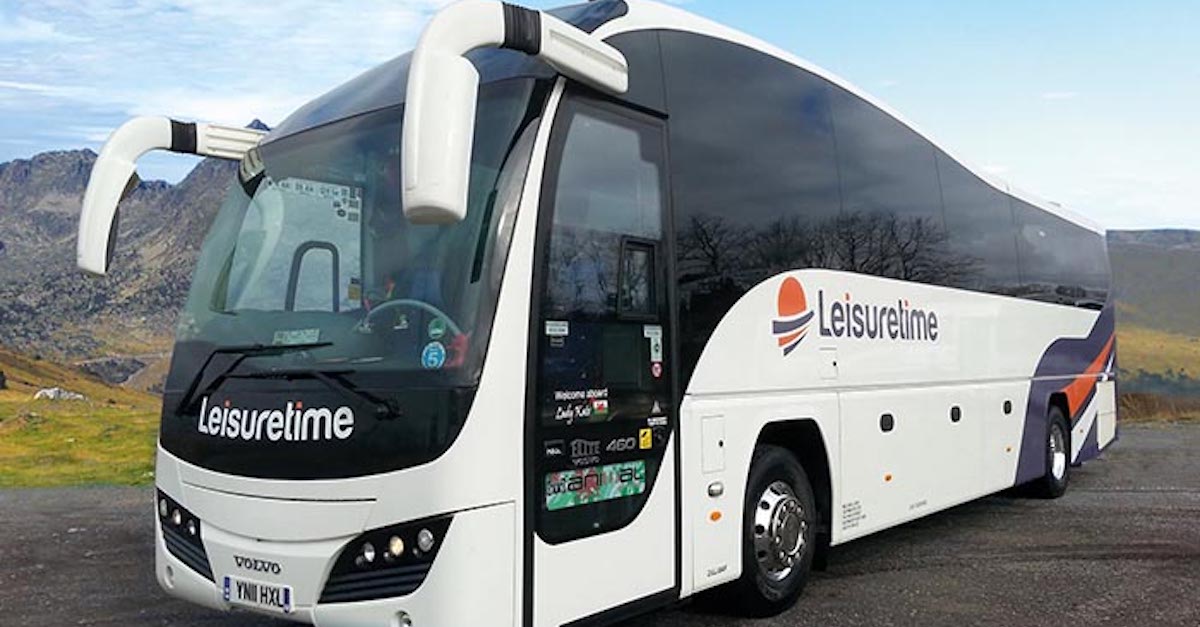How GM, Ford and Tesla are tackling the national EV charging challenge
There are not nearly enough electric vehicle charging stations today. GM, Ford and Tesla are taking a variety of approaches to the problem.

Charging port for a Ford Motor Co. Mustang during the Washington Auto Show in Washington, D.C., on Friday, Jan. 21, 2022.
Al Drago | Bloomberg | Getty Images
More people than ever are buying electric vehicles. There are about 2 million EVs on the road in the U.S., up six-fold since 2016, but the number of EVs is still a very small slice of the more than 280 million vehicles in operation. Some factors, such as upfront cost and battery range, are largely manufacturing and innovation challenges being handled inside companies. But another source of consumer resistance opens up a complex set of questions that will need to be addressed on a macro level – the availability of charging stations and a power grid that can handle them.
Currently, cars and trucks combine to produce about one-fifth of green-house gas emissions. In order to meet net-zero emissions targets in the decades ahead, consumers are going to have to buy a lot of electric vehicles, and they are going to need a lot of places to charge them. The Department of Energy actively tracks the total number of public charging stations (the total number of charging ports is higher) in the country, a number that now stands at 55,000. If that sounds like a lot, consider that there are close to three times as many gas stations. Also, bear in mind that although EV charge times vary widely, they are significantly slower than gassing up, so congestion is a significant issue at charging stations.
According to a recent McKinsey & Company Report, about 20-times more charging stations will be needed than are now available, up to 1.2 million public chargers.
Where competition has been an important part of EV innovation, public and private cooperation will help to drive development of EV-charging infrastructure. The Biden administration recently announced new standards for EV charging in line with its goal of installing 500,000 additional charging stations by 2030, and the $7.5 billion set aside by the Bipartisan Infrastructure Law represents the government's first investment in EV chargers. The minimum standards will help establish the groundwork for states to build charging station projects that are accessible to all drivers regardless of the location, EV brand or charging company.
"Public funding is especially important for highway corridor charging given the challenging business case as the EV market continues grow," said a GM spokesman.
Infrastructure doesn't have the appeal of splashy new vehicle rollouts like the Chevy Silverado EV or Ford's electric F-150 Lightning pickup, and as the GM spokesman explained, there is an ongoing need for cross-sector collaboration and policy support to streamline permitting, proactively engage electric utilities, accelerate siting and grid interconnection timelines, and eliminate other outstanding infrastructure deployment barriers.
"This really requires an 'all hands on deck' approach," he said.
Part of the shortfall of charging infrastructure has to do with the nature of EV purchases thus far. Tesla represents 80% of the EV market in the U.S. With an entry-level Tesla costing around $50,000 and 80% of Tesla owners charging at home, the development of public charging stations has not kept pace with future needs.
But there are signs this is changing.
Tesla, which had used its own proprietary technology for its Supercharger network, has been moving away from that model. Last July, Tesla CEO Elon Musk noted in a tweet that Tesla created its own network because none existed. "We created our own connector, as there was no standard back then & Tesla was only maker of long range electric cars. That said, we're making our Supercharger network open to all other EVs."
As GM sees it, the sheer number of chargers, while important, is only part of the story.
"We believe the focus needs to be on building an overall charging ecosystem that enables convenient, reliable, affordable charging access for all, and this is what we're trying to do with Ultium Charge 360," the GM spokesman said. This includes expanding access at home (including multi-family housing), at work, and in strategic public locations, as well as for additional use cases like fleets. "It also means getting the right chargers in the right locations to meet customer needs and build confidence both now and in the future," he said.
At the Future of the Car conference in May, Musk said that Tesla will add CCS connectors to its Supercharger network: "It's a little trickier in the U.S. because we have a different connector than the rest of the industry, but we will be adding the rest of the industry connector as an option to Superchargers in the U.S.," Musk said. The combined-charger system (CCS) is standard across Europe, and adding the Tesla adapter gives Tesla-owners access to more charging options, combined with allowing non-Tesla owners access to the Supercharger network.
In April, Musk — whose relationship with the Biden administration, and Democratic Party, has been tense — sat down with Biden officials and GM CEO Mary Barra to discuss EV-charging infrastructure. The Department of Transportation described the event in cooperative terms: "Broad consensus that charging stations and vehicles need to be interoperable and provide a seamless user experience, no matter what car you drive or where you charge your EV," said a DoT statement.
Over the next ten years, Ford plans to increase spending on EVs by as much as $20 billion. Its BlueOval Charging Network is the largest public charging network in North America, with close to 20,000 charging stations featuring 60,000-plus plugs. Speaking about the rapid acceleration of its EV plans, Ford CEO Jim Farley said at a recent EV launch event, "That's something that no one would have believed just two years ago from us."
The culture surrounding EV-charging stations differs significantly from that of gas stations, with the prevalence of at-home charging raising questions about equity and access, and a divide between urban and rural areas, according to the Environmental and Energy Study Institute. There are significant parts of rural America where one could drive for some time without seeing an EV-charging station, while filling stations punctuate the landscape at regular intervals. GM and Ford will have to be a big part of this essential effort to combat "charging deserts."
GM, through its Dealer Community Charging Program, will distribute up to 10 charging stations to its EV dealers. This will add some 40,000 stations, evenly distributed across the country, particularly in underserved areas. This will help place many consumers in range of charging: nearly 90% of Americans live within 10 miles of a GM dealership. As part of a $750 million initiative, these stations can be distributed at the discretion of the GM dealerships throughout their communities.
"We want to give customers the right tools and access to charging where and when they need it," GM President Mark Reuss said in a statement last October about its goals, "while working with our dealer network to accelerate the expansion of accessible charging in underserved, rural and urban areas."
GM expects most charging will occur at home, which is convenient for most customers. McKinsey estimates that the U.S. will need 28 million private chargers by 2030. GM's Ultium smart chargers, which will be available later this year, will give customers and businesses the opportunity to roll the cost into lease payments and vehicle loans.
It is also placing charging in public locations where customers are already spending time intervals of 30 minutes to a few hours — such as grocery stores and gyms – to enable more convenient public charging. An example of this is GM's collaboration with EVgo to install 3,250 DC fast chargers in major metropolitan areas by the end of 2025.
As challenging as the issue of charging deserts is the question of urban infrastructure, where even willing buyers – many of whom are also apartment dwellers – may have significant challenges in locating convenient and reliable charging stations. In an urban setting or in the case of urban fleets, a big issue is lack of garages or other facilities where individual charging stalls could be deployed. According to Yury Dvorkin, assistant professor of electrical and computer engineering and member of the C2SMART Tier 1 Transport Center at NYU Tandon, a key solution is public charging infrastructure, which needs to be high-wattage (to ensure high charging power and thus charging speed) and multi-stall (to ensure that many EVs can charge at the same time).
"If you can buy a relatively cheap EV (if you collect all incentives and tax benefits), the purchasing price is affordable to a vast number of people living in U.S. urban areas and the real limit for adoption is in fact access to public charging infrastructure," Dvorkin said.
The major automakers are calling for an extension of those government incentives for EV purchases. Meanwhile, the recent infrastructure funding is an "important step forward" for EV infrastructure, Dvorkin said, but more as an opening to further R&D than a cure all.
There are numerous "techno-economic challenges," Dvorkin said, to be solved beyond the direct control of the auto companies. Primary ones are permitting restrictions and, more essentially, power grid limitations. "Permitting is still a challenge and it may take months until an EV charging station is approved," he said. "And there is a need to ensure that the grid is capable of delivering electric power to the EV charging stations; this requires the development of tools for deciding where EV charging infrastructure should be deployed in order to satisfy consumer demand and power grid limits."
Actions from legacy automakers like GM and Ford underscore the cultural shift built into the move toward EVs and can spur a change in the national automotive culture. Although later to the game than Tesla, the big automakers represent core notions of the automobile long woven into the American imagination: freedom, possibility, escape — none of which play out very well if you can't keep your battery charged. As GM and Ford pick up the pace of their EV manufacturing, and Tesla expands access to its EV-charging infrastructure, the larger imagination can move with them, with more readily available charging along the way.
"It's Ford Motor Company … the Model-T. This is what we do. We aren't some new start-up," Farley recently told CNBC.
–By Trevor Laurence Jockims, special to CNBC.com

 Kass
Kass 
































